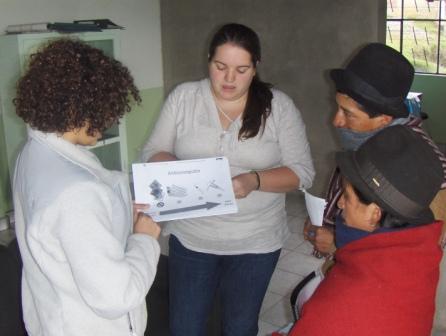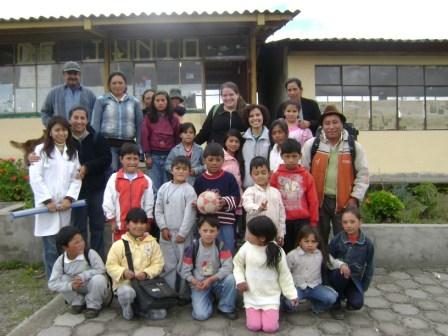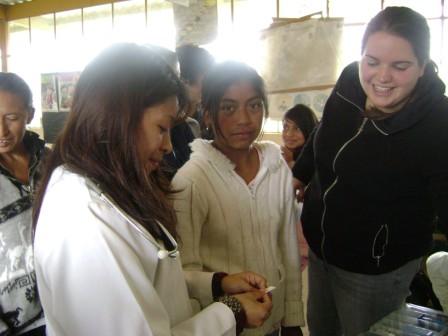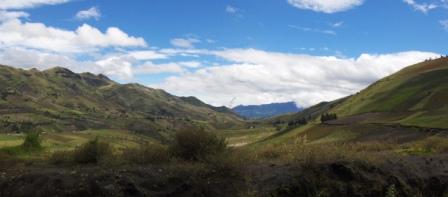A bit of progress and a real taste of culture
Independent Project: Recycling Update
Since we last talked about Amanda’s efforts to start recycling programs at Fundación Futuro clinics, we’ve seen the project get off the ground with a great response! Bins for glass, plastic and paper are now installed at the clinics in Planchaloma and Yatzaputzan, as well as the women´s cooperative in Yatzaputzan. The bins in Planchaloma are currently overflowing and ready for transport next time we return to Quito. Amanda found a company that is willing to buy recyclable items, so we are hoping to turn this environmentally-inspired project into a money-maker for the clinic.
Independent Project: Library
While Amanda’s project has been taking hold, I have started my own independent project. Since coming to Ecuador I have been catching up on my ever-growing reading list. One book that I particularly enjoyed was The Boy Who Harnessed the Wind, the account of a boy from rural Malawi who improved living conditions for his family and village by building a windmill–a project inspired and guided by books from his local library. The description of his village reminded me in many ways of Planchaloma–many people without proper healthcare, electricity, education, water supply, etc. However, the people here do not have access to a library of bookstore. While there is an internet cafe, its users are limited to children playing games after school. With this in mind, we decided to launch a modest book collection at the clinic where patients can read where they wait for the doctor and check out books to take home. Right now we have a modest selection of 82 books, ranging from science textbooks to children’s stories, but Lorena, the nurse at the clinic, had the same idea as Amanda and: the clinic has volunteered to use the funds produced by the recycling program to buy additional books for the library.
While most people were initially hesitant to use the library, once we introduced people the system and assured them that it was a free service, we have gotten a positive response. We hope that word spreads around the community so that people are aware of this resource.

Lab-in-a-Backpack Progress
The clinic in Planchaloma recieved some exciting news this week with regard to the Lab-in-a-backpack: they have contracted a lab tech who will visit the clinic every Saturday to use the materials in the pack! Amanda and I demonstrated the pack to her today, and she was very impressed with what all it contained. We are relieved to know that the backpack will continue to be used once we go home next week.
We also had the opportunity to demonstrate Sally to the lab tech and her son, who is a doctor. He was especially excited about the design since he himself had constructed a manual centrifuge using a bicycle in med school.
View From Our Window
So this isn’t exactly project related, but one of my favorite blogs has a “View From Your Window” series, and I thought I would post some pictures of the spectacular panoramic we are lucky enough to wake up to everyday (well, as long as it’s not too cloudy).

To the West: Las Ilinizas, which we affectionately refer to as the Lord of the Rings mountains

To the East: Cotopaxi, the volcano that lends its name to the province
In our spare time, we have tried to take in the amazing countryside, and one afternoon we hiked up a mountain (it’s really more of a hill, but at this altitude it felt like a mountain).

As long as we’re off topic, Amanda and I would like to take a moment to mention the weather in Planchaloma, which we have decided is more fickle than Houston’s. Though today was the hottest day of our internship, it hailed. Five minutes later, the sun came out and we were treated to an incredible rainbow over the cascading hills.
Ecuador Culture
Since arriving in Ecuador, and particularly Planchaloma, we have had the privilege of experiencing the rich, indigenous culture here. We have gone to festivals, watched dance performances, and observed high school graduations. It’s a great way to take a break from work and get to know the way of life here a little bit better.

Cuy, AKA guinea pig, one of Ecuador's delicacies. Everyone here thinks it's hilarious that Americans keep these animals as pets!

 Hi Everyone! My name is Lila Kerr and I just graduated from Rice with a degree in Sociology and minors in Global Health Technologies and Poverty, Justice and Human Capabilities. This summer, I will begin working for Unite for Sight, a global health non-profit organization based in New Haven, where I'll help coordinate research projects, organize their annual conference, and steer their chapters on college campuses. However, before I move to Connecticut, I am so excited for the opportunity to go to Botswana with BTB! I am looking forward to sharing my experiences with you here, and I welcome your feedback along the way!
Hi Everyone! My name is Lila Kerr and I just graduated from Rice with a degree in Sociology and minors in Global Health Technologies and Poverty, Justice and Human Capabilities. This summer, I will begin working for Unite for Sight, a global health non-profit organization based in New Haven, where I'll help coordinate research projects, organize their annual conference, and steer their chapters on college campuses. However, before I move to Connecticut, I am so excited for the opportunity to go to Botswana with BTB! I am looking forward to sharing my experiences with you here, and I welcome your feedback along the way!








